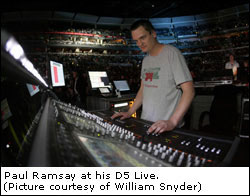DiGiCo D5 Live rocks with The Who
Source: DiGiCo; 04/16/07
Having just completed the U.S. leg of their world tour, legendary rock band The Who are about to take Europe by storm. And not content with the already extensive itinerary, on March 31, in between the two legs, the band appeared at The Royal Albert Hall for Teenage Cancer Trust, a now annual weeklong event organized by Roger Daltrey.

Paul Ramsay at his D5 Live. (Picture courtesy of William Snyder)
The band’s Front of House engineer is Paul Ramsay and he and his DiGiCo D5 Live have occupied this position since 2004. “I’ve actually been mixing on the D5 since the start of 2003,” he says. “I was first shown it by Robert Collins [FoH for The Who prior to Paul’s tenure, Eric Clapton, Mark Knopfler, etc] and I’ve been using it with all the acts I work with since.”
Paul’s first experience with the D5 set the tone for the future: “I was able to get audio out of the console within minutes of using it and without looking at a manual,” he smiles. “It really is very easy to use: in fact, most opening act engineers who haven’t used the console before are generally a bit nervous, but within a few minutes of me showing them around, they’re busy doing their soundcheck, are happy with the results and surprised at how easy it is to use.
“But most important for me is the sound quality of the pre amps. They are excellent and on par with, if not above that of, high quality analogue desks. The D5 has an analogue feel about it in all respects, with instant access to the control via the touch screens and no multiple menus to go through. The EQ has a warm analogue feel about it and I love the fact you can have multiple screens doing separate things. I’ve rarely had to look at the manual for anything, or had to contact anyone, but even so, the back up from the team at DiGiCo has been amazing.”
With all sound requirements supplied by Entec Sound and Light, the arena tour features a flown d&b J-Series loudspeaker system comprising 48 J8s, eight J12s and 16 J-SUBs, with ground stacked components comprising six B2 and eight Q7 all running on d&b D12 amplifiers using Rope software. For the Albert Hall there was a reduced system consisting of 24 J8s, four J12s, 12 J-SUBs, 18 Q1s and four B2-SUBs. Q7’s, Q10’s and E3’s were also used for the choir stall and near field coverage.
“The Albert Hall is a fantastic place, but wasn’t design for amplified music,” explains Paul. “The most important thing is not to go too loud. There’s a threshold for the room and once you go above it, the mix turns to a mess. The same applies for the sub bass and trying to keep the stage level down helps as well, as does a good PA system such as the d&b J-Series.”
Back at the D5, Paul uses 60 inputs as standard, and with FoH audience mics, effects returns and playback he totals around 80. Outputs, he says, get a little more complicated. “FoH has the usual in and outs of external outboard and I run the whole system AES all the way into the amplifiers, which makes a huge difference. I use the console’s snapshot facility, one for each song in the set, and it’s very helpful as a good base to start each song. I pre-programmed everything in rehearsals last May in Bray and I’m continually updating. I also use Midi to send a program change to my external effects. It saves me having to dash round the console at the end of each song to reset: I can just push a button and concentrate on the mix without having to worry about missing a cue.”
Paul uses some external units, but also a lot of the D5’s internal effects including gates and, for the most part, the internal compressors. “But I do use valve compressors on a few channels to warm things up and give a different tone to certain inputs, as well as my trusty TC 6000, which I run AES in and out of the D5.”
Every show is recorded and sold on the internet within a few days of the show as both an official bootleg CD and a DVD with 5.1 audio. This is facilitated via a backstage setup that includes two Radar 24 track hard disk recorders, two Digidesign 002s and four CDRs. Paul supplies eight channels of analogue recording to the 002 from the mix he creates on the D5, minus a few channels which are sent separately to the remaining six channels of the 002. This, in turn, is used as the 5.1 mix on the DVD.
“The CDRs are a stereo mix I create from FoH, which will be used to play some of the show on The Who satellite radio station the next day,” says Paul. “The Radar takes a multitrack of most of the channels, but as there are only 48 tracks, I sub mix a few instruments to this. I also have a MADI recorder at FoH to record the show for back up.”
In addition to the post-show sales, Paul also uses the recording to allow him to do ‘virtual’ soundchecks. “This is a tool I dreamt of having for years,” he concludes. “Being able to run same loop of a song and fine tune a mix is fantastic. It’s also great as The Who rarely soundcheck, so I can walk the room with the show mix going and fine-tune my mixes. It really would be very difficult to do all this on an analogue console!”